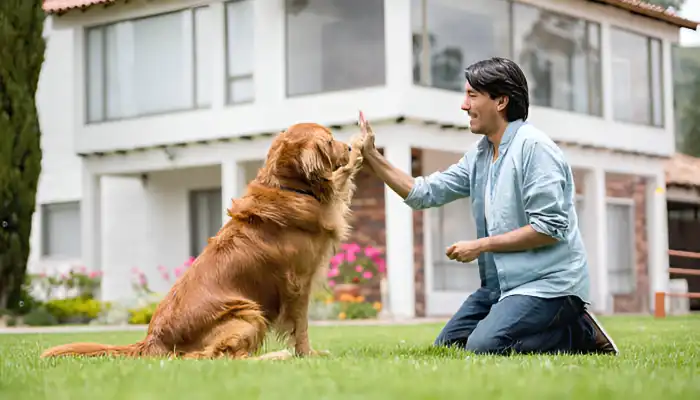If you have a pet, there’s a high chance you have thought of, “How Do You Say “Hi” in Dog Language?” Every dog owner will agree that greeting dogs is unique and important. Although dogs do not understand our words, they have developed their own complex system of communication which ranges from simple tail wags to complex body movements.
While there are different dog translator apps and devices available, you can try it on your own. In this blog, we’ll go over the different methods of how to say ‘greet’ in dog language while ensuring you create your very own dog-human bond.

Basics of Dog Greetings and Communication
Before we get into “How Do You Say “Hi” in Dog Language.” The first step is knowing how dogs communicate, which fundamentally is different from humans. Dogs communicate using a combination of body movements, sounds, and aromas. The signals used are entirely relative to shape, character, and surroundings.
Major Characteristics of Dog Communication
- Tail Wagging: One of the most emotional parts of a dog’s body is the tail. Dogs expressing excitement, happiness, or friend’s edges often wag their tails. Tail movements also indicate their mood.
- Ear Position: Ears can tell you a lot about a dog’s feelings. Curiosity or excitement is often shown by forward-facing ears, while pinned-back ears usually signal anxiety or fear.
- Body Posture: Relaxed body postures usually show a happy, calm dog, while tense movements could show aggression or caution.
- Barking: Dogs use barking as a means to communicate, and attention-seeking behavior, alertness, and greetings are only some of the reasons behind barking. The tone, pitch, and context vary meaning.
Having learned the essentials to understanding your pet’s communication it is time we learn how to appropriately say hello to them.
How Can You Say “Hi” in Dog Language?
Dogs appreciate when they are spoken to in a calm and positive manner. Here is a list of phrases for How Do You Say “Hi” in Dog Language?
1. The Dog Greet: Friendly Eye Contact and Communication
In the same way people do, dogs also like to bond with each other through eye contact. A soft gaze is a sign to your dog that you mean no harm. When meeting with your dog, make sure to provide soothing and welcoming expressions with your eyes.
- What to do: Gaze downwards and keep looking at your dog in a slow manner as this will give them a non-threatening vibe and impression.
- Why it Works: In the dog-eat-dog world, unfamiliar dogs showing intense expressions tend to be viewed as a threat, but those a bit familiar can be approached by a human.
2. Watching Posture Changes During Communication
Dogs are deconstructing movements on a whole other level. Changing your posture to a more relaxed lookout will help him feel more at ease. Raising your body tends to instill fear so try not.
- What to do: Greet your furry friend with a calm demeanor that is also accompanied by a little squatting. Try not to stand straight up around them especially.
- Why it Works: Dogs interpret the manner in which we approach them as how we desire to interact. Lowering your body tends to suggest that you mean no harm and have friendly intentions.
3. Tail Wagging
Tail wagging is an obvious way to say “Hello,” in Dog Language. If a dog vigorously reacts towards your presence with a wagging tail, then it signifies that the dog is happy to see you.
- What to do: Let the dog sniff you first, before allowing it to greet you with tail wagging, and vice versa.
- Why it works: Dogs use tail wagging as a means to convey joy and excitement. It is another way of positively greeting your dog that makes him feel warm and at home.
4. Soft Vocalization
Dogs do not have the ability to articulate speech, but they can communicate through varied sounds. Dogs often bark, whine, or growl to express their feelings. To express love towards your dog, you can also speak in a warm and soft voice.
- What to do: Go “Hi!” in a soft voice that is a little higher and friendly in tone while talking to the dog.
- Why it works: A dog will always respond to the calm tone because it signifies approachability and a non-threatening figure.
Studying Your Dog’s Behavior
Observing your dog’s behavior helps in determining How Do You Say “Hi” in Dog Language? Not all dogs will greet you in the same manner. Therefore, Let us break down the reactions into what you might see based of your dog’s replies:
| Dog Response | Meaning |
|---|---|
| Wagging Tail (fast) | Excited to see you, happy |
| Wagging Tail (slow) | Calm and relaxed |
| Ears Pinned Back | Nervous or anxious |
| Play Bow | Ready to play, happy |
| Growling or Barking | Alert or territorial (can be positive or negative) |
Important Factors to Consider When a Dog is Greeting You
- Relaxed Body: If a body is loose and in a comfortable position, they are relaxed.
- Tail Movement: They should always be loose and in motion yet never stiff.
- Excited Barking: Defiantly means a dog is expressing joy and happiness, especially when coupled with a high-pitched voice.
Conclusion
So, How Do You Say “Hi” in Dog Language? A soft tone of voice like “Hi” should be accompanied with a gentle smile. You should also maintain eye contact with your pooch and pay attention to personal space. It is crucial dog owners learn how read the body language of their dogs. There are lots of ways dogs express happiness like wagging their tails which an owner should know to respond appropriately.
